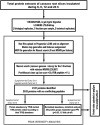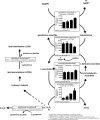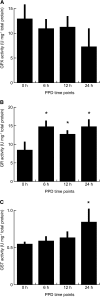Large-Scale Proteomics of the Cassava Storage Root and Identification of a Target Gene to Reduce Postharvest Deterioration
- PMID: 24876255
- PMCID: PMC4079358
- DOI: 10.1105/tpc.114.123927
Large-Scale Proteomics of the Cassava Storage Root and Identification of a Target Gene to Reduce Postharvest Deterioration
Abstract
Cassava (Manihot esculenta) is the most important root crop in the tropics, but rapid postharvest physiological deterioration (PPD) of the root is a major constraint to commercial cassava production. We established a reliable method for image-based PPD symptom quantification and used label-free quantitative proteomics to generate an extensive cassava root and PPD proteome. Over 2600 unique proteins were identified in the cassava root, and nearly 300 proteins showed significant abundance regulation during PPD. We identified protein abundance modulation in pathways associated with oxidative stress, phenylpropanoid biosynthesis (including scopoletin), the glutathione cycle, fatty acid α-oxidation, folate transformation, and the sulfate reduction II pathway. Increasing protein abundances and enzymatic activities of glutathione-associated enzymes, including glutathione reductases, glutaredoxins, and glutathione S-transferases, indicated a key role for ascorbate/glutathione cycles. Based on combined proteomics data, enzymatic activities, and lipid peroxidation assays, we identified glutathione peroxidase as a candidate for reducing PPD. Transgenic cassava overexpressing a cytosolic glutathione peroxidase in storage roots showed delayed PPD and reduced lipid peroxidation as well as decreased H2O2 accumulation. Quantitative proteomics data from ethene and phenylpropanoid pathways indicate additional gene candidates to further delay PPD. Cassava root proteomics data are available at www.pep2pro.ethz.ch for easy access and comparison with other proteomics data.
© 2014 American Society of Plant Biologists. All rights reserved.
Figures





Similar articles
-
RNAi inhibition of feruloyl CoA 6'-hydroxylase reduces scopoletin biosynthesis and post-harvest physiological deterioration in cassava (Manihot esculenta Crantz) storage roots.Plant Mol Biol. 2017 May;94(1-2):185-195. doi: 10.1007/s11103-017-0602-z. Epub 2017 Mar 18. Plant Mol Biol. 2017. PMID: 28315989 Free PMC article.
-
Melatonin attenuates postharvest physiological deterioration of cassava storage roots.J Pineal Res. 2016 May;60(4):424-34. doi: 10.1111/jpi.12325. Epub 2016 Apr 2. J Pineal Res. 2016. PMID: 26989849
-
Proteomic analysis of injured storage roots in cassava (Manihot esculenta Crantz) under postharvest physiological deterioration.PLoS One. 2017 Mar 24;12(3):e0174238. doi: 10.1371/journal.pone.0174238. eCollection 2017. PLoS One. 2017. PMID: 28339481 Free PMC article.
-
Cassava postharvest physiological deterioration: a complex phenomenon involving calcium signaling, reactive oxygen species and programmed cell death.Acta Physiol Plant. 2017;39(4):91. doi: 10.1007/s11738-017-2382-0. Epub 2017 Mar 3. Acta Physiol Plant. 2017. PMID: 28316353 Free PMC article. Review.
-
An overview of protein identification studies in cassava.Curr Protein Pept Sci. 2015;16(3):219-27. doi: 10.2174/1389203716666150224145407. Curr Protein Pept Sci. 2015. PMID: 25707473 Review.
Cited by
-
Cassava shrunken-2 homolog MeAPL3 determines storage root starch and dry matter content and modulates storage root postharvest physiological deterioration.Plant Mol Biol. 2022 Jun;109(3):283-299. doi: 10.1007/s11103-020-00995-z. Epub 2020 Oct 6. Plant Mol Biol. 2022. PMID: 32270429 Free PMC article.
-
Genome-Wide Analyses of Calcium Sensors Reveal Their Involvement in Drought Stress Response and Storage Roots Deterioration after Harvest in Cassava.Genes (Basel). 2018 Apr 19;9(4):221. doi: 10.3390/genes9040221. Genes (Basel). 2018. PMID: 29671773 Free PMC article.
-
Genomic analyses of heat stress transcription factors (HSFs) in simulated drought stress response and storage root deterioration after harvest in cassava.Mol Biol Rep. 2020 Aug;47(8):5997-6007. doi: 10.1007/s11033-020-05673-3. Epub 2020 Jul 24. Mol Biol Rep. 2020. PMID: 32710389
-
Comparative Physiological and Transcriptomic Analyses Reveal the Actions of Melatonin in the Delay of Postharvest Physiological Deterioration of Cassava.Front Plant Sci. 2016 May 27;7:736. doi: 10.3389/fpls.2016.00736. eCollection 2016. Front Plant Sci. 2016. PMID: 27303428 Free PMC article.
-
Proteome Mapping of South African Cassava Mosaic Virus-Infected Susceptible and Tolerant Landraces of Cassava.Proteomes. 2021 Oct 23;9(4):41. doi: 10.3390/proteomes9040041. Proteomes. 2021. PMID: 34842800 Free PMC article.
References
-
- Achidi A.U., Ajayi O.A., Bokanga M., Maziya-Dixon B. (2005). The use of cassava leaves as food in Africa. Ecol. Food Nutr. 44: 423–435
-
- Alexa A., Rahnenführer J., Lengauer T. (2006). Improved scoring of functional groups from gene expression data by decorrelating GO graph structure. Bioinformatics 22: 1600–1607 - PubMed
-
- Amako K., Chen G.X., Asada K. (1994). Separate assays specific for ascorbate peroxidase and guaiacol peroxidase and for the chloroplastic and cytosolic isozymes of ascorbate peroxidase in plants. Plant Cell Physiol. 35: 497–504
-
- Baba A.I., Nogueira F.C.S., Pinheiro C.B., Brasil J.N., Jereissati E.S., Juca T.L., Soares A.A., Santos M.F., Domont G.B., Campos F.A.P. (2008). Proteome analysis of secondary somatic embryogenesis in cassava (Manihot esculenta). Plant Sci. 175: 717–723
-
- Baerenfaller K., Hirsch-Hoffmann M., Svozil J., Hull R., Russenberger D., Bischof S., Lu Q., Gruissem W., Baginsky S. (2011). pep2pro: A new tool for comprehensive proteome data analysis to reveal information about organ-specific proteomes in Arabidopsis thaliana. Integr. Biol. (Camb.) 3: 225–237 - PubMed
LinkOut - more resources
Full Text Sources
Other Literature Sources
Molecular Biology Databases

